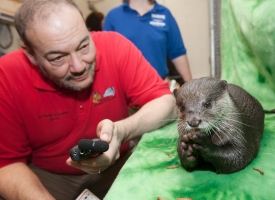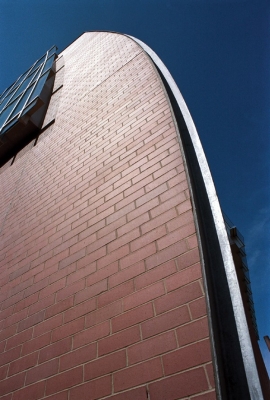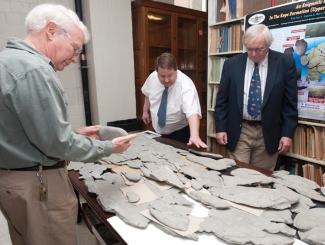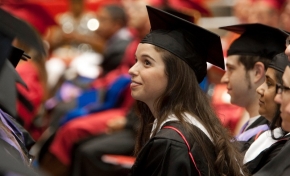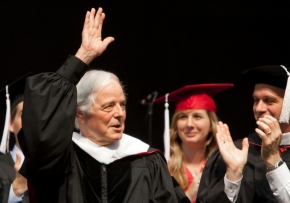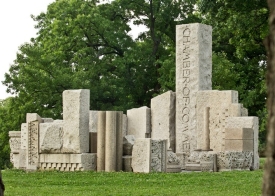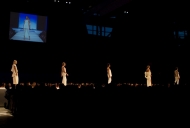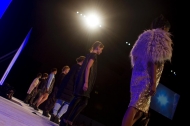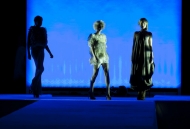University of Cincinnati campus news
Medical breakthroughs
Vocalization project
UC researcher Peter Scheifele [right] records an otter vocalizing in different situations. Scientists with UC’s FETCH-LAB (Facility for Education and Testing of Canine Hearing and Lab Animal Bioacoustics) have partnered with biologists at the Newport Aquarium in Kentucky to study the hearing and vocalization of several animals — including otters, sharks and sea horses — housed at the aquarium. By increasing knowledge of these species’ hearing and environment, researchers believe the project could eventually improve captive breeding programs for rare, endangered animals. Read more.
Infant growth and cholesterol
Ensuring a baby's health starts in the womb, and the contributing factors are complex. A new grant from the Bill and Melinda Gates Foundation will allow UC metabolic disease researchers to study maternal cholesterol and its connection to fetal growth. Fetuses that grow slowly (called intrauterine growth restriction or IUGR), have an increased risk of infection, disease and mortality, an issue of paramount importance in developing countries where 90 percent of the world's IUGR infants are born. The new UC study will investigate whether or not cholesterol is a beneficial factor that helps a fetus grow normally during gestation. Read more.
New treatment for Parkinson's
UC researchers took part in a national study that showed that an intestinal gel delivered through a surgically implanted tube is more effective for Parkinson's disease patients than similar medication taken orally. The gel, known as levodopa carbidopa, was shown to increase the time patients were free of symptoms of advanced Parkinson's disease. Read more.

Secondhand smoke exposure
The negative health effects of early-life exposure to secondhand smoke appear to impact girls more than boys — particularly those with early-life allergies. Epidemiologists with UC's Cincinnati Childhood Allergy and Air Pollution Study found that children exposed to high levels of secondhand smoke who also had allergies during early childhood (age 2) are at greater risk for decreased lung function at age 7 compared to children who had not developed allergies by this age.
Brain tumor vaccines
Vaccine clinical trials under way at the UC Cancer Institute and Brain Tumor Center are taking aim at one of the most commonly diagnosed brain tumors. Glioblastoma multiforme (GBM) is a fast-growing malignant brain tumor that occurs in the central nervous system and accounts for 60 percent of the 17,000 new primary brain tumors diagnosed annually in the United States. One of the trials targets a specific mutation which is present in about 30 percent of patients with GBM. Read more.
Circadian rhythms research
Could a better understanding of circadian rhythms lead to enhanced knowledge of disease treatments, trauma care and human combat performance? That is the question an interdisciplinary research team based in molecular and cellular physiology will seek to answer with a $3.7 million grant from the U.S. Department of Defense. Researchers hope their studies will reveal potential methods to improve care for patients with abdominal trauma or exposure to gut pathogens. Read more.
New academic master plan
UC's Academic Master Plan, developed by provost and interim president Santa Ono, was unveiled this spring with an expanded investment of approximately $10 million. The master plan is a component of "UC2019 Accelerating Our Transformation," the strategic plan that sets the university's agenda through 2019 and commits the university to become a first-choice destination for students, patients, faculty and staff.
Of the allocations, $4.25 million is designated for enhancing the student experience, diversity and global engagement; $3.32 million toward faculty recruitment, teaching excellence and research; and $2.45 million for core support in the form of improvements to classrooms for 21st century learning, academic technology tools, streamlining scholarship coordination and more.
UC architecture accolades
Four University of Cincinnati buildings were designated as some of "The 50 Most Amazing Examples of College Architecture" by Top Colleges Online, a website providing reviews and college rankings for prospective students. The total of four listings was more than any other university in the U.S.
The Vontz Center for Molecular Studies was described as a "panoply of curved lines" with "skewed windows" and "tilted angles." The Steger Student Life Center "is like a bizarre and wonderful marriage between a curve and the prow of a ship." The Michael Graves-designed Engineering Research Center was listed as "an eminently pragmatic building in space and form." The highest ranked UC building on the list, the Campus Recreation Center, is "a chimera of a building … slammed together in an almost terrifying way."
Not the first accolades for UC architecture, Forbes magazine named UC among the world's most beautiful college campuses in 2010, and Delta Sky Magazine included UC among the world's top ten inspiring campuses in 2011.
Amateur paleontologist discovers 'monster'
Around 450 million years ago, shallow seas covered the Cincinnati region and harbored one very large and now very mysterious organism. Despite its size, no one has ever found a fossil of this "monster" until its discovery by an amateur paleontologist last year.
The fossilized specimen, a roughly elliptical shape with multiple lobes, totaling almost seven feet in length, has professionals puzzled. "It’s definitely a new discovery," says David Meyer of UC’s geology department. "And we’re sure it's biological. We just don’t know yet exactly what it is."
Remains of the unidentified creature were found near Covington, Ky., by Ron Fine of Dayton, a member of the Dry Dredgers, an association of amateur paleontologists based at UC. "I knew right away that I had found an unusual fossil," he says.
"Imagine a saguaro cactus with flattened branches and horizontal stripes in place of the usual vertical stripes. That's the best description I can give."
For more than 200 years, the rocks of the Cincinnati region have been among the most studied in all of paleontology, but Fine's discovery might be the largest fossil recovered from the area, Meyer adds.
Biofuel from university's fryer fat
Environmental engineering faculty and students have an innovative approach to turn waste cooking oil from campus eateries into an alternative fuel source, resulting in a collaboration that could help Cincinnati's own grease traps power the region.
Every month for years now, engineering professor Mingming Lu and her team of students have collected around 35 gallons of waste fryer fat from UC dining spots. After cleaning and treating the used cooking oil, the process yields biodiesel — at a cost of about $1.35 per gallon — which helps fire UC's power plant.
This year the team presented their solution as part of a U.S. Environmental Protection Agency design expo and won an $87,000 grant to expand the fryer-to-fuel project into a regional effort. The Cincinnati Metropolitan Sewer District, Bluegrass Biodiesel and UC have partnered to test methods for extracting oil from local grease traps around Cincinnati at a 100-gallon pilot facility for the sewer district.

Build a better bottle
Blind and visually impaired patients may have an easier-to-use pill bottle if the senior capstone project of design students Alex Broerman and Ashley Ma gets produced.
After interviewing prospective clients, the pair created an innovative design that eliminates the need for often-difficult and easily lost twist caps by incorporating a childproof, hinged lid that flips open. To those lids, they added multiple distinct textures and colors to differentiate medications. The design does not include Braille since only 10 percent of people who are blind or have visual impairments can read Braille.
The stout body and a nearly 2-inch-wide rectangular opening allow a user easy access while making the bottle less likely to tip over. Broerman and Ma, who graduated from the College of Design, Architecture, Art, and Planning in June, have filed for a provisional patent on their design.

Snack study: Kids eat more junk food
UC researchers have further confirmed something most parents already knew. Elementary-age children are scarfing down way more junk foods such as chips, candy and cookies than they are eating nutritious snacks such as fruits and vegetables.
Manoj Sharma, professor of health promotion and education at UC, co-authored a study of 167 fourth- and fifth-graders who reported their snacking behavior over a 24-hour period. What they found was the youngsters' daily calorie count from low-nutrition foods far outpaced that which they receive from produce, specifically 300 calories to 45. Further, girls reported eating significantly more high-calorie snacks (348) than boys (238).
The study suggests that part of the increase in unhealthy snacking stems from the growing number of children who skip breakfast. Also, children make more of their own choices when snacking versus what they are served at dinner. In the battle against childhood obesity, unhealthy snack foods are a particular concern because they are both cheap and easy for children to purchase, researchers point out.
University welcomes two new deans
The University of Cincinnati Clifton campus welcomed two new deans this summer. Xuemao "Shimo" Wang is the new dean and university librarian. UC alum Ronald Jackson II heads the McMicken College of Arts and Sciences.
Wang comes to UC from Emory University where he served as associate vice provost of university libraries since 2009. Jackson, A&S '91, M (A&S) '93, who earned degrees in communication, returned to his hometown and home college from the University of Illinois at Urbana-Champaign.
Record graduating class
The University of Cincinnati handed out more than 5,600 degrees during Commencement weekend June 8-9 — the most since 1980. Local and national journalist and humanitarian Nick Clooney was awarded an honorary doctorate and addressed the 2012 graduates at all three ceremonies.
"We are rattling and clanking our way deeper into the 21st century, adjusting to a vulnerable global economy," said Clooney. "We're held in the embrace of an immediacy never before imagined.
"Ready or not, change is coming. We won't meet it successfully unless our intellectual centers like the University of Cincinnati continue to raise the bar for what we expect of ourselves."
Honorary degrees were also given to Thane Maynard, executive director of the Cincinnati Zoo, and Robert Woodson Sr., founder and president of the Center for Neighborhood Enterprise.
Clermont College's new field
The UC Clermont College Cougars baseball team will open 2013 on a new home field thanks to Cincinnati Reds outfielder Jay Bruce.
Bruce, through the Reds Community Fund, is underwriting a major upgrade to one of the existing fields at the Batavia Township Community Center, which will become the new home of the Cougars. The field, only minutes from the Clermont campus, will be far more convenient for the program, which has used the Blue Ash Crosley Field, more than 20 miles away, for practices and home games.
Bruce asked that the complex be named Brian Wilson Field after the Reds scout who discovered him. Wilson died tragically from a heart attack at age 33 in 2006.
Richardson’s rocks turn 40
This November marks the 40th anniversary of the dedication of "Operation Resurrection," a student-designed monument that commemorates local work of famed architect H.H. Richardson, the man who inspired the architectural style known as Richardsonian Romanesque in the late 1800s.
Standing in Burnet Woods across the street from UC's northwest corner, the structure comprises stone relics of the Richardson-designed Cincinnati Chamber of Commerce building, one of the region’s most significant public structures before it burned in 1911. The city's best remaining example of this architectural style is Cincinnati City Hall, designed by Cincinnati-based architect Samuel Hannaford.
In the late '60s, former UC architectural history professor Bill Rudd sparked the idea for a monument when he discovered that the remains of the Chamber of Commerce building were still in the area. Students dreamed up "Operation Resurrection" and began raising money by selling T-shirts, buttons and sweatshirts bearing Richardson's face.
DAAP professor John Peterson kept the project moving forward and helped assemble a memorial design contest, won by Stephen Carter, DAAP '69. The project took a giant leap in 1970 following the Kent State shootings when UC suspended classes. During the campus shutdown, students and faculty oversaw the pouring of the foundation and slab for the memorial. After additional fundraising, the stones were erected at the park in 1972.
Link
More photos and an essaay on the rocks by former professor Bill Rudd
Score one for CCM
College-Conservatory of Music students will soon be leaving UC ready to jump directly into the commercial music scene and perhaps even operate their own studios.
Starting this fall, CCM began offering a bachelor's in commercial music production, a program unlike any other in the region or the state and one that is attracting applicants from around the world. The degree combines core training in music theory, composition, arrangement and musicianship along with recording-studio techniques, commercial music and media technologies.
By the time students finish, they will have gained skills in composing for television and commercial media, producing, editing, running live sound, songwriting and film scoring. They will also graduate with a minor in music business entrepreneurship.
Cool, classy couture
UC's College of Design, Architecture, Art, and Planning staged its 61st annual fashion show in June. The event, sponsored by Macy's, showcased the work of graduating fashion design students before a sell-out crowd. Nationally recognized beauty-industry leader and longtime DAAP supporter Frederic Holzberger was honored.
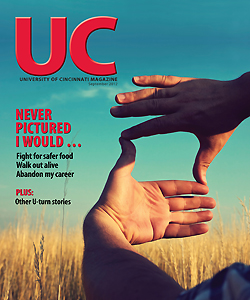
 Past Issues
Past Issues